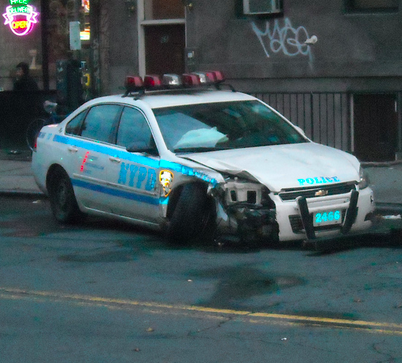Drivers of city government vehicles crashed at least 5,605 times last year, including 378 collisions that resulted in injury and seven fatalities, according to a new city database. Of the injury crashes, 41 harmed pedestrians and 11 hurt cyclists. The database collects information on crashes involving vehicles from all city agencies -- except NYPD, which has yet to share its data.

"It’s the first time that we’ve had a citywide program of tracking all the collisions that involve the city’s fleet," said Keith Kerman, deputy commissioner for fleet management at the Department of Citywide Administrative Services. "It’s one of our major commitments as part of Vision Zero for the city fleet."
The database is called CRASH and contains information going back to October 2013. CRASH is populated with data from the standard DMV crash report form, such as the date, time, and location of a crash, as well as the vehicles, pedestrians, or cyclists involved and whether the crash resulted in injuries. It also includes causal factors and traffic conditions at the time of the crash.
NYPD has not responded to questions about why it is not yet reporting data to the CRASH database. The police have "additional reporting and management needs," Kerman said, including marking whether a crash occurred during enforcement activity and whether emergency lights and sirens were on at the time of the crash.
Tracking whether lights and sirens are turned on at the time of a crash in a citywide database could be important in cases where a pedestrian or cyclist is injured by an NYPD driver. After 24-year-old Ryo Oyamada was killed by an officer driving a cruiser in 2013, the department said the vehicle's emergency lights were engaged. That claim was later contradicted by witnesses, video footage, and testimony from the officer himself.
FDNY, which like the police department also regularly engages its lights and sirens, is already participating in the CRASH database. Kerman says he is working with NYPD to bring its data into the system.
Kerman said Department of Sanitation vehicles are involved in the highest number of crashes in the database, followed by the fire department. This aligns with pedestrian personal injury claims tracked by Comptroller Scott Stringer, who found NYPD is far and away the top agency for crash claims, followed by DSNY and FDNY.
The CRASH database is revealing trends about crashes involving city-owned vehicles. For example, a high percentage of injury crashes in the database happen when a city driver rear-ends a private car. “Rear-end collisions are one of the most preventable types of collisions,” Kerman said. Ways to avoid these crashes, such as slowing down and ensuring a safe following distance, are now a larger part of the training DCAS provides to city drivers.
Since the start of 2014, the agency has provided defensive driving training to 17,000 city employees, a 10-fold increase over its pre-Vision Zero levels, Kerman said.
In addition to the database of crashes, DCAS is also rolling out CANceiver technology, which records driving behavior like speeding and hard braking. So far, the city has installed the gadgets on 16,000 vehicles, with 7,000 more to go. While CANceivers can be used in crash investigations, they aren't automatically linked to the CRASH database. “They’re really two separate rollouts," Kerman said. "In time we’ll be able to have some more data on [crash] causes.”
Kerman says DCAS is focused right now on working with agencies to use information from the CRASH database to improve safety. CRASH data is not yet available on the city's open data portal; Kerman says DCAS is considering how to roll out the data in compliance with the city's open data law.





